
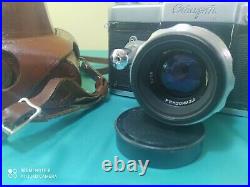
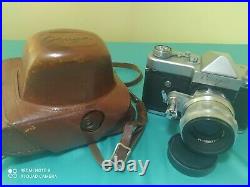
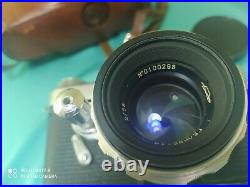
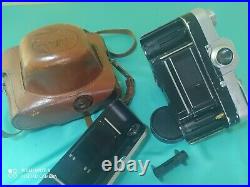
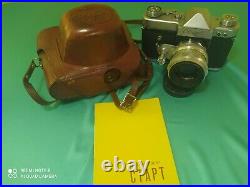
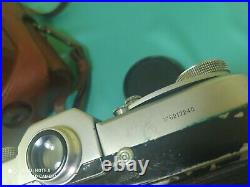


START camera from Evgeniy Okulov collection 1. Year of issue 1958 - 1964.
Lens mount original bayonet mount with union nut. Photographic material Photographic film type 135. Mechanical shutter, curtain-slit with fabric shutters.
Photo flash Synchro contact (two sockets). Viewfinder focusing screen with wedges, detachable pentaprism or shaft. Weight 1300 (in case)[1].
In total, about 76,500 pieces were produced [4] [5]. "Start" was a camera of a higher class than the Zenit models produced in the same years, and is considered one of the attempts to create a Soviet professional photo system [6]. The attempt was unsuccessful, including due to the low reliability of the camera: out of ten copies of the Start that were tested in the Ogonyok magazine, not one worked for more than a month [7]. The improved model "Start-2" with a TTL exposure meter was not mass-produced. The main differences between the "Start" and other Soviet small-format "SLRs" of those years were the interchangeable viewfinder and the bayonet mount of the lens with a semi-automatic pressure diaphragm. The shutter with an anchor delay mechanism worked out the full range of shutter speeds from 1/1000 to a whole second, which was also uncharacteristic for mass cameras [9].
The camera together with the lens consisted of 550 parts[14]. The cost of optical-mechanical products of such complexity is much higher than that of mass-produced Zeniths. The retail price of even 130 rubles[15] required subsidizing production at the expense of other divisions of the plant or directly from the state budget[16]. Forced savings became the reason for the low reliability of the camera and its lack of demand in the photographic equipment market.
An equally important role in the low popularity of the "Start" was played by the lack of lenses with the appropriate mount on sale: threaded optics M39 × 1 with an adapter were used as interchangeable ones [17]. The production of "Start" was discontinued in 1964 in connection with the launch of the promising Zenit-4 line with a central shutter [5].
Instead of a take-up spool, you can install a second cassette. The design of the sliding cover locks allows the use, in addition to standard cassettes with "velvet", curtain cassettes of the "Contax" type (in the USSR, the "FKTs" type)[18].
Type of focal shutter - mechanical, curtain-slit with horizontal movement of fabric shutters. Shutter speeds - from 1 to 1/1000 s (automatic), "B" (by hand) and long (not available when using a standard lens)[19]. The mirror is of a "sticky" type, that is, it falls into the working position only when the shutter is cocked. Standard lens - "Helios-44" 2/58 mm with a push diaphragm mechanism: when you press the shutter release button, it closes to the working value.
The aperture button, located on the lens barrel, is paired with a shutter release on the front of the camera, similar to Exakta, Topcon, Alpa and Miranda cameras [10]. The working length of the camera is 42 mm. Pentaprism - removable, can be replaced by a shaft. Pentaprism eyepiece magnification - 5×. The size of the frame image visible in the viewfinder is 22 × 32.5 mm [20], which is much larger than that of the Zeniths. Type of focusing screen - frosted glass with Doden wedges. There were also screens without wedges, but they were not widely used. There are two PC-type sync contacts for connecting photo flashes: one for electronic (with a lightning sign) and the other for. This item is in the category "Cameras & Photo\Lenses & Filters\Lenses". The seller is "svetlana-8867" and is located in this country: KZ. This item can be shipped worldwide.
- Compatible Brand: For Contax
- Maximum Aperture: f/2.0
- Mount: Sony E-mount
- Focal Length: 58mm
- Year Manufactured: 1980s
- Exterior Material: Aluminum
- Brand: PENTAX
- Series: Pentax SMC
- Type: Standard
- Focus Type: Manual
- Manufacturer Warranty: 2 Years
- Country/Region of Manufacture: Ukraine
- Focal Length Type: Fixed/Prime

